Dispersed settlements are generally found in the areas of extreme climates, hilly tracts, thick forests, grasslands, poor agricultural lands, areas of extensive cultivation and the areas where it is essential that the farmer should live on his agricultural land rather than in a distant village/settlement.
One thing which may be said with a high degree of confidence about the dispersed settlements is that they are relatively recent in age.
ADVERTISEMENTS:
The Steppee grasslands of Kazakistan, Uzbekistan, Turkmenistan, and Kirgizistan, Russia—east of Ural are some of the interesting examples of dispersed settlements which came into existence in the late 19th century and the early parts of the 20th century.
The dispersed settlements in the Prairies of USA and Canada, the Pampas of Argentina, the Velds of South Africa and the Downs (grasslands) of Australia developed mostly around 200 years ago.
In the desert and semi-desert regions of Rajasthan, in the forest lands of North-East India, the Siwaliks, the side valleys of Jammu & Kashmir, the higher altitudes of Himalayas and parts of the peninsular India, dispersed settlements started developing during the medieval period.
Such settlements are also found in the under populated areas, such as Central Australia, New Zealand, Northern Canada, western parts of the USA, Scotland, Scandinavian countries, South-West Asia, oasis of Sahara and the greater parts of Africa excluding the coastal areas and irrigated tracts.
ADVERTISEMENTS:
There are, however, some areas with highly productive agricultural land and good climate characterized with dispersed settlements. In such areas, the main causes of scattered settlements are historical or socio-cultural.
For example, if a village is overpopulated and grows enormous in size, part of its population leaves the village to develop a new settlement which is often a dispersed one. Such settlements may be observed throughout the plains of Northern India in between the two large compact settlements.
Similarly, when people moved into the marshy land, khadar (new alluvial) tracts of rivers, or marginal upland farms, they usually built isolated farms rather than nucleated or compact settlements.
This is mainly due to the fact that in the marginal poor lands, a larger area is required for sustenance.

